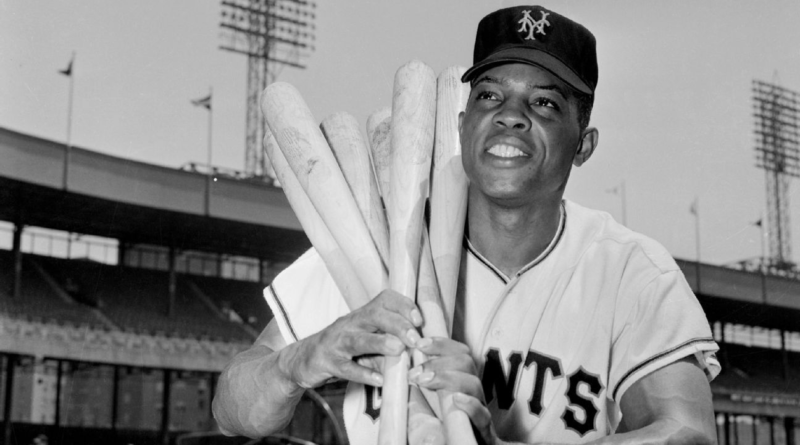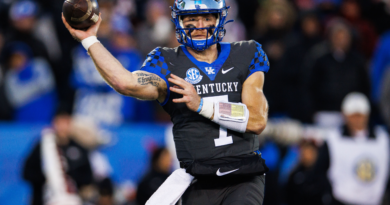Legendary outfielder Willie Mays dies at age 93
Willie Mays, whose unmatched collection of skills made him the greatest center fielder who ever lived, died Tuesday afternoon in the Bay Area. He was 93.
“My father has passed away peacefully and among loved ones,” Michael Mays said in a statement released by the San Francisco Giants. “I want to thank you all from the bottom of my broken heart for the unwavering love you have shown him over the years. You have been his life’s blood.”
The “Say Hey Kid” left an indelible mark on the sport, with his name a constant throughout baseball’s hallowed record book and his defensive prowess — epitomized by “The Catch” in Game 1 of the 1954 World Series — second to none.
All told, in a career that spanned 20-plus years (1951-73) — most of them with his beloved Giants — he made 24 All-Star teams, won two NL MVP awards and had 12 Gold Gloves. He ranks sixth all time in home runs (660), seventh in runs scored (2,068), 12th in RBIs (1,909) and 13th in hits (3,293).
“Today we have lost a true legend”, Giants chairman Greg Johnson said in a statement. “In the pantheon of baseball greats, Willie Mays’ combination of tremendous talent, keen intellect, showmanship, and boundless joy set him apart. A 24-time All-Star, the Say Hey Kid is the ultimate Forever Giant.
“He had a profound influence not only on the game of baseball, but on the fabric of America. He was an inspiration and a hero who will be forever remembered and deeply missed.”
Fellow Giants legend Barry Bonds, who is Mays’ godson and sits just five spots above him on the all-time home run leaderboard, said Mays “helped shape me to be who I am today” in a message shared on social media.
Mays’ death comes two days before the Giants are set to play the St. Louis Cardinals at Rickwood Field in Birmingham, Alabama, in a game honoring Mays and the Negro Leagues as a whole. It was announced Monday that Mays would not be able to attend.
Mays, who was born on May 6, 1931, and grew up in Alabama, began his professional career at the age of 17 in 1948 with the Birmingham Black Barons, helping the team to the Negro League World Series that season.
MLB has been working with the city of Birmingham and Friends of Rickwood nonprofit group to renovate the 10,800-seat ballpark, which at 114 years old is the oldest professional ballpark in the United States.
“Thursday’s game at historic Rickwood Field was designed to be a celebration of Willie Mays and his peers,” MLB commissioner Rob Manfred said in a statement. “With sadness in our hearts, it will now also serve as a national remembrance of an American who will forever remain on the short list of the most impactful individuals our great game has ever known.”
The Giants were playing the Cubs in Chicago on Tuesday night; the Wrigley Field crowd of 36,292 stood in a salute to Mays when his death was announced on the left field video board in the sixth inning. A moment of silence was held between innings.
Giants manager Bob Melvin said he learned of Mays’ death right before the start of the game. Then most of his players became aware once the contest started.
“It’s heavy hearts for not only the Bay Area and New York where he started, but the baseball world,” Melvin said. “This is one of the true icons of the game.”
The 62-year-old Melvin, from Palo Alto, California, said he grew up watching Mays play at Candlestick Park.
“I loved baseball because of Willie Mays,” Melvin said. “It meant that much.”
Melvin said the Giants would’ve loved if he could’ve watched the matchup Thursday at Rickwood Field.
“If possible, it adds more to going there,” he said.
Giants starter Logan Webb said he found out about Mays’ death during the Cubs’ announcement, as he was taking the mound to pitch the sixth inning.
“It was hard at first. I took my hat off and I was looking at the scoreboard and just thinking about him,” Webb said. “I kind of looked at the umpire and I was like, ‘I think you need to stop the clock.’ I needed to take a moment to think about it and be prideful for the jersey I was wearing, the hat I was wearing, knowing Willie did the same.”
Webb said the team will play Thursday’s game in Mays’ honor. Right fielder Mike Yastrzemski also reflected on his interactions with Mays, recalling how the Hall of Famer insisted he should be playing center field when he was first called up.
“He said he couldn’t see much of the game but he could see that,” Yastrzemski said. “It was pretty cool.”
Mays excelled in baseball, football and basketball as a high schooler. But his love of baseball trumped all sports. Since he was still in school while playing for the Black Barons, he only played on the weekends with the club; he traveled with Birmingham when school was out.
The New York Giants caught wind of Mays and purchased his contract from Birmingham in 1950. Mays had no trouble acclimating, batting .353 in 81 games with Trenton that season. In 1951, Mays broke out with the Triple-A Minneapolis Millers; he batted .477 in 35 games before the Giants recalled him in May.
At age 20, Mays was the 10th Black player in major league history. After going hitless in his first three games, Mays’ first career hit with the Giants was a home run off Hall of Famer Warren Spahn in the first inning of the Giants’ 4-1 loss to the Braves on May 28, 1951. Mays was also on-deck when the Giants’ Bobby Thomson hit his NL pennant-winning home run against the Dodgers on Oct. 3, 1951, famously known as “The Shot Heard ‘Round the World.”
The Korean War interrupted Mays’ career in 1952. He played in 34 games for the Giants (batting .236) before he was drafted by the U.S. Army. Mays was assigned to Fort Eustis in Virginia, and he kept his skills sharp by playing games regularly. Mays also missed the entire 1953 season because of military service; he did not return to the Giants until the spring of 1954.
But the layoff from professional baseball did not affect him. Mays won the first of his two career NL MVP awards that season, leading the league in batting at .345 and hitting 41 home runs to go along with 110 RBIs. Mays won his other NL MVP in 1965.
There will never be another quite like Willie Mays 🧡 pic.twitter.com/I95JW1buJF
— SFGiants (@SFGiants) June 19, 2024
“I fell in love with baseball because of Willie, plain and simple,” Giants president and chief executive officer Larry Baer said. “My childhood was defined by going to Candlestick with my dad, watching Willie patrol center field with grace and the ultimate athleticism. Over the past 30 years, working with Willie, and seeing firsthand his zest for life and unbridled passion for giving to young players and kids, has been one of the joys of my life.”
During Game 1 of the 1954 World Series against Cleveland at the Polo Grounds, Mays made one of the most famous plays in baseball history. With the score tied at 2 and two runners on base, Cleveland’s Vic Wertz hit a 2-1 pitch to deep center in the top of the eighth inning. Mays sprinted toward the wall with his back away from Wertz. He made a basket catch while on the run, pivoted and fired the ball into the infield. Mays’ catch and quick relay throw prevented both runners from scoring; the Giants won the game 5-2 in 10 innings.
Today, the play is simply known as “The Catch.”
“It wasn’t no lucky catch,” Mays noted years later.
On May 11, 1972, Mays was traded from the Giants to the New York Mets for pitcher Charlie Williams and $50,000. After the 1973 season — when Mays helped the Mets win the NL pennant — Mays retired. In 1979, he was elected to the Baseball Hall of Fame.
In a statement from the MLBPA, executive director Tony Clark said Mays “played the game with an earnestness, a joy and a perpetual smile that resonated with fans everywhere.”
“He will be remembered for his integrity, his commitment to excellence and a level of greatness that spanned generations,” Clark said.
In his 22-year career, Mays led the NL in home runs four times, and when he retired, his 660 home runs ranked third in big league history; he now ranks sixth behind Bonds, Hank Aaron, Ruth, Alex Rodriguez and Albert Pujols. He also finished with 3,283 hits (12th all time) and 1,903 RBIs (12th all-time) in his career.
“His incredible achievements and statistics do not begin to describe the awe that came with watching Willie Mays dominate the game in every way imaginable,” Manfred said in his statement. “We will never forget this true Giant on and off the field. On behalf of Major League Baseball, I extend my deepest condolences to Willie’s family, his friends across our game, Giants fans everywhere, and his countless admirers across the world.”
With the exception of 1951, when he wore No. 14, Mays wore No. 24 his entire career. Mays’ legacy still resonates in San Francisco. The Giants’ ballpark is located at 24 Willie Mays Plaza, complete with a statue of Mays. The city of San Francisco also celebrates every May 24 as Willie Mays Day.
ESPN’s Jesse Rogers and The Associated Press contributed to this report.



